<Previous
Next>
Scott Adams' Dilbert character was born not out of some abstract impression
of the stereotypical engineer, but of the tendency - sometimes tragically - of an
individual's life vocation to reflect his innate tendencies and preferences. Having
myself been born with at least some level of manifestation of that well-documented
genetic trait known in the medical community as
The Knack, I tend to spend my spare time indulging in
things technical. That can run the gamut of subjects from tearing apart electromechanical
devices, to building model boats, rockets and airplanes, renovating houses, working
on cars, building and restoring clocks, reading books on physics, astronomy and
mathematics, and maybe tending to watch TV shows like Numb3rs and Built
It Bigger.
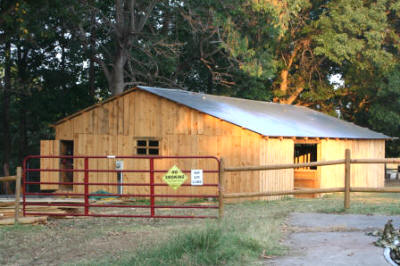
Now that the kids are grown, college educated, and married, vacation time consists
of not only maintaining our (Melanie and me) own stuff, but also helping out with
the kids' stuff as well. In October, we drove down to Greensboro, NC, to visit my
daughter, Sally, and her husband, Matt, at their recently acquired horse farm. They
bought it in May of this year and by the time we arrived, with the help of some
friends, had totally razed an old, dilapidated 3-stall horse barn and hay barn and
erected from their own plans a 60x40-foot, 7-stall horse barn (with tack room and
office) and a 12x40-foot hay and equipment barn. Sally has been riding and instructing
for about eight years and has built an amazing riding school on her own, while boarding
at other facilities, and now finally has her own place -
Equine Kingdom Riding Academy.
Matt just graduated from UNCG with a degree in biology and is a certified dog trainer,
so a kennel and training facilities will eventually inhabit the property as well.
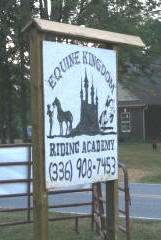 Cutting wood and swinging hammers
are within the capability of most people, but when the time comes for electrical
wiring and plumbing, that often gives pause to the most ambitious of builders. That's
where I come in. I carry a pair of lineman's pliers (ref
Dragnet,
start at 45 seconds)...
Cutting wood and swinging hammers
are within the capability of most people, but when the time comes for electrical
wiring and plumbing, that often gives pause to the most ambitious of builders. That's
where I come in. I carry a pair of lineman's pliers (ref
Dragnet,
start at 45 seconds)...
Having begun my career many moons ago as an electrician through vocational school
and a couple years of practice, then entering into electronics through the
USAF, then earning a BSEE degree,
I have kept up electrical wiring skills through the year while renovating many houses
and doing wiring for other people as a favor. So, when the barn was ready for wiring,
I was ready to wire it.
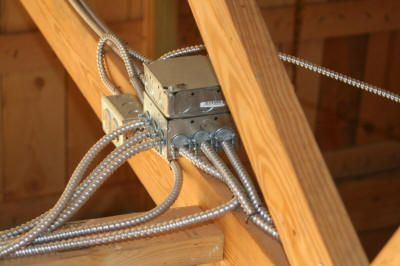
Since Melanie and I now live in Erie, PA, the initial planning was done via e-mail
exchanges and phone calls to get dimensions and preferences. Wiring diagrams and
parts lists were created just like I am accustomed to doing for projects on engineering
jobs. The kids considered it at least slightly
obsessive compulsive personality disorder-like in nature considering
their work was done in a rather ad hoc manner, but my limited availability justified
such an approach. After a few trips to the local Lowe's home improvement store,
I was able to supply a complete parts list that included item description, quantity,
Lowe's stock numbers, and even URLs for every component. Then, they handed the list
to an employee in Greensboro and came back later to pay for and pick up everything.
It worked like a charm, with only a couple trips necessary during the execution
phase for parts needed to accommodated Sally's requested changes.
Unlike when you have to actually pay someone to do work for you, when you have
the free labor of a willing craftsman, the list of features tends to increase beyond
basics. Among other things, their barn now sports the following electrical amenities:
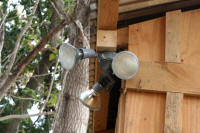 5, 4-foot, 4-bulb, T-8 (more efficient than
T-12) fluorescent light fixtures in the aisle-way
5, 4-foot, 4-bulb, T-8 (more efficient than
T-12) fluorescent light fixtures in the aisle-way- 2 more of same in the office and tack room
- An overhead, single-bulb standard light fixture above each stall, with switch
control
- An overhead duplex receptacle above each stall, with switch control (for fan
or heater).
- A duplex receptacle at each stall
- 500 W halogen floodlights at both entrances and facing the horse wash pad (switches
mounted inside).
-
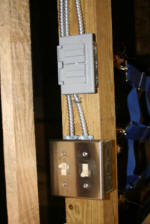 3-bulb, motion/light sensor-controlled floodlights
at all 4 corners of the barn (disabling switches mounted inside).
3-bulb, motion/light sensor-controlled floodlights
at all 4 corners of the barn (disabling switches mounted inside).
- Decorative porch wall light at office/tack room door.
- All receptacle circuits protected by ground fault interrupter (GFI) circuit
breakers.
- Light and receptacle circuits separated per
NEC. Multiple circuits for each to prevent one fault from disabling
entire barn. Circuit load planned for no more than 50% of breaker rating under normal
conditions (lots of overhead for additional current demand).
- Metal device and junction boxes used throughout for ruggedness, fire prevention,
and immunity to varmint attack.
- Metal-clad cabling (12/2 THHN w/separate integrated ground wire) and approved
connectors and insulator bushings used throughout for same reasons.
- Grounding screws connected on all devices and boxes per NEC.
- Underground feeder circuit run to hay /equipment barn. GFI protection provided
at load end.
Now, while I have always been pretty good at the planning and execution phases of
projects, estimating the time needed to accomplish each task (I hate making schedules)
has always been my weak point. Such was the case here as well. I figured that out
of the four full days that Melanie and I would be visiting (plus a day each way
for travelling 650 miles), it would take a day to mount all the boxes and fixtures,
then another day and a half for wiring.
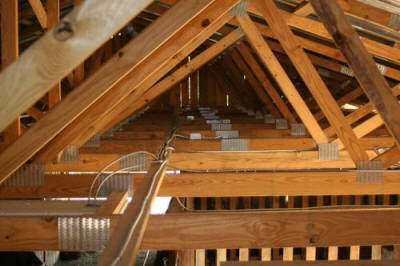
Well, that estimate might have been good if plastic-sheathed Romex type wire
was being used (standard house wiring). However, installing the metal clad wiring
involved carefully cutting through the wound armor without nicking the wire insulation
inside. There is a trick to doing it, and I am well practiced in doing it from my
former life as an electrician wiring commercial buildings, but it takes at least
twice the time for making each connection to a box or fixture than does the simpler
Romex that requires only stripping with a knife.
Oh yeah, there is also that obsessive compulsiveness issue that always tends
to slow me down. For some reason I possess an innate compulsion to keep everything
as straight, plumb, horizontal, parallel, and perpendicular as possible. It could
be labeled a personal pride thing, but the Freudian psychoanalytical community's
diagnosis would probably be more apt in my case.
For all the above reasons, the job actually took four full days, with the last
splice being made at around 9:00 pm on the evening before we headed north back to
Erie. I figure that I put in a little over 50 hours in four days, and that is with
help from Matt for half the time.
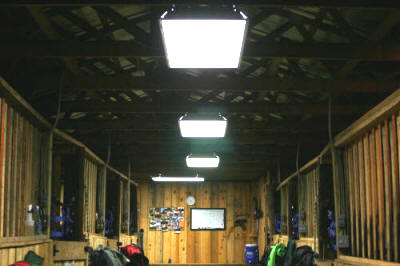
There is great satisfaction in completing the job, then standing back and surveying
all that which you have created. There was one short in the entire job, and that
was not a hot-to-neutral or hot-to-ground type of short, but rather one between
the ground and the neutral in one receptacle box.
That kind of short is only noticed in a GFI-protected circuit. Had it been on
a standard circuit breaker, it would never have manifested itself. You might be
tempted to think that having the neutral shorted to the ground is not really a problem
since, after all, the grounds and neutrals are bonded together back at the circuit
breaker panel. It does create a possible hazard, though, since it presents an opportunity
for some or all of the current from the hot wire to return via the ground wire,
which is only truly at ground potential back at the panel (due to conductor resistance).
If there is an open neutral somewhere in the circuit, an otherwise ground potential
wire can be carrying all or part of the circuit's return current - a job normally
assigned to the neutral wire, and the very condition which a GFI circuit is designed
to protect against.
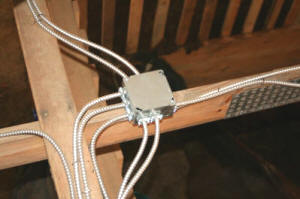
So, in the end, while Sally and Melanie did daughter-mother things all week and
Matt divided his time between his full-time job and helping me, I spent my entire
"vacation" from morning to evening wiring a couple barns. Though my 50-something
back was aching, fingers were utterly sore from cutting cable, twisting wire nuts,
hammering staples, and turning screws, I count it time well spent. A few months
from now we'll tackle adding switches and receptacles to the human barn (primary
residence), and maybe run a new waterline out to the horse barn.
Here's the most interesting thing about the whole experience: As I was installing
the final piece of armored cable between a junction box and an overhead stall light,
it was exactly long enough to complete the job. That is, I began with four, 250-foot
spools of cable and had exactly nothing left over at the end. It took precisely
1,000 feet of cable - with no wasted lengths - to do the job. Kinda cool,
n'est-ce pas?
Posted December 30, 2010








 "
"


 5, 4-foot, 4-bulb, T-8 (more efficient than
T-12) fluorescent light fixtures in the aisle-way
5, 4-foot, 4-bulb, T-8 (more efficient than
T-12) fluorescent light fixtures in the aisle-way 3-bulb, motion/light sensor-controlled floodlights
at all 4 corners of the barn (disabling switches mounted inside).
3-bulb, motion/light sensor-controlled floodlights
at all 4 corners of the barn (disabling switches mounted inside).


